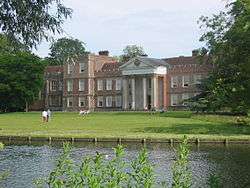The Vyne

The Vyne is a 16th-century country house outside Sherborne St John near Basingstoke in Hampshire, England.
The Vyne was built for Lord Sandys, King Henry VIII's Lord Chamberlain. The house retains its Tudor chapel, with stained glass. The classical portico on the north front was added in 1654 by Inigo Jones's pupil John Webb. In the mid-eighteenth century The Vyne belonged to Horace Walpole's close friend John Chaloner Chute, who designed the Palladian staircase, whose magnificent apparent scale belies its actual small size.
The Vyne was bequeathed by its final Chute owner, Sir Charles Chute, to the National Trust in 1958.
Each year a number of concerts, plays and family events are run.
The grounds contain large woodland and a wetlands nesting site which is populated by swans and common redshanks. There are a number of woodland, wetland and parkland walking trails. Dogs are welcome into the grounds (on leads), in Morgaston Woods and the Organic Parklands (under direct control).
Inspiration for Lord of the Rings
The Vyne holds an inscribed Roman ring as well as a lead tablet that speaks of a curse on the one who stole it. J. R. R. Tolkien was asked to comment on it as an expert on Anglo-Saxon history, including its connection to a mine fabled to have been dug by dwarves, and a few days after began writing Lord of the Rings.[1][2]
References
- ↑ Maev Kennedy (2 April 2013). "The Hobbit ring that may have inspired Tolkien put on show". The Guardian. Retrieved 15 April 2013.
- ↑ NPR: J.R.R. Tolkien's Ring On Display At Estate's Exhibit
External links
| Wikimedia Commons has media related to The Vyne. |
- The Vyne information at the National Trust
- The Vyne, Hants.
- Historic England. "Details from image database (139033)". Images of England.
Coordinates: 51°18′25″N 1°5′18″W / 51.30694°N 1.08833°W